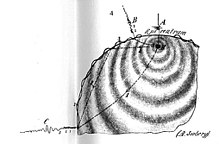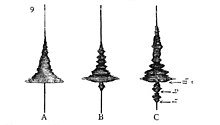August Heinrich Sieberg
August Heinrich Sieberg (born December 23, 1875 in Aachen , † November 18, 1945 in Jena ) was a German geophysicist . He did research mainly in the field of seismology and developed an earthquake scale as well as a tsunami scale.
Scientific career
| Illustrations by A. Sieberg in the entry Earthquake ( Zemětřesení ) in Otto's encyclopedia (Ottův slovník naučný, vol. 27, pp. 565–571, Prague, 1908). |
Sieberg studied natural sciences at the TH Aachen and the universities of Strasbourg , Freiburg and Jena ; he also studied architecture. From 1895 he was an assistant at the Meteorological Observatory Aachen, between 1904 and 1914 at the Imperial Main Station for Earthquake Research in Strasbourg, founded in 1899. From 1910 he was a part-time employee of the Strasbourg central office of the International Seismological Association (ISA), today's International Association of Seismology and Physics of the Earth's Interior .
After the First World War , Strasbourg became French and in 1919 Sieberg, together with the director of the Strasbourg main station, Oskar Hecker , moved to the newly established Reich Center for Earthquake Research in Jena, the predecessor of today's Moxa Geodynamic Observatory . Under Hecker as director, Sieberg was department head for macroseismics and a member of the government. Sieberg received his doctorate from Jena University in 1921 and qualified as a professor in 1922 in geophysics. This year he was involved in the founding of the German Seismological Society . In 1924 he became an associate professor. After Hecker's retirement in 1932 Sieberg was appointed acting head of the Reich Center for Earthquake Research, and in June 1936 he became its director. At his suggestion and according to his plans, the Reich Ministry of Science set up the German Reich Earthquake Service.
In 1925, Sieberg received the golden ring of honor for his work in setting up the German Museum in Munich, and from 1934 he was a member of the Board of Directors. In 1933 August Sieberg was elected a member of the Leopoldina . In 1937 he received an honorary doctorate from the University of Athens . In 1939 he joined the Bulgarian Seismological Service in Sofia as an external member.
Scientific work
| Characteristic | Greatest acceleration | |
|---|---|---|
| 1 | imperceptibly | up to 2.5 mm / sec 2 |
| 2 | very easy | 2.6 to 5 mm / sec 2 |
| 3 | light | 6 to 10 mm / sec 2 |
| 4th | moderate | 11 to 25 mm / sec 2 |
| 5 | pretty strong | 26 to 50 mm / sec 2 |
| 6th | strong | 51 to 100 mm / sec 2 |
| 7th | very strong | 101 to 250 mm / sec 2 |
| 8th | destructive | 251 to 500 mm / sec 2 |
| 9 | devastating | 501 to 1000 mm / sec 2 |
| 10 | devastating | 1001 to 2500 mm / sec 2 |
| 11 | catastrophe | 2501 to 5000 mm / sec 2 |
| 12 | Big catastrophe | from 5000 mm / sec 2 |
| Mercalli-Cancani-Sieberg scale (1923) | ||
As a seismologist he worked on the compilation of earthquake catalogs and the geographical distribution of earthquakes. Further research areas were tectonics and the analysis of macroseismic data. Sieberg was aware that the nature of the subsoil and the construction method have a strong influence on the damage caused by an earthquake, and was very interested in the social effects of earthquakes.
In 1912 Sieberg introduced the twelve-part Mercalli-Cancani-Sieberg scale as a further development of the Mercalli-Cancani scale. The scale is structured in such a way that each scale division corresponds approximately to twice the horizontal basic acceleration of the previous one.
In 1927 he developed the Sieberg scale , a six-part scale for assessing the strength of tsunamis on the basis of their impact on people, buildings and nature, which was adapted to the usual twelve-part earthquake scales by Nicholas Ambraseys in 1962 in the form of the Sieberg-Ambraseys scale . In 1939 he published the first earthquake catalog for Germany and neighboring areas.
Fonts
- 1904: Handbook of Earthquake Science. F. Vieweg and son, Braunschweig
- 1914: Introduction to earthquake and volcanic studies in southern Italy. G. Fischer, Jena
- 1922: The spread of earthquakes due to recent macro and micro seismic observations and their significance for questions of tectonics. G. Fischer, Jena
- 1923: Geological, physical and applied earthquake science. G. Fischer, Jena
- 1927: Geological introduction to geophysics: For students of natural sciences, engineering and mining, as well as for self-study. G. Fischer, Jena
- 1932: earthquake geography. Handbook of Geophysics, Vol. 4, Lfg. 3, Borntraeger, Berlin
- 1933: Earthquake research and its utilization for technology, mining and geology. G. Fischer, Jena
- 1937: Contributions to earthquake engineering and soil mechanics. Publications of the Reich Institute for Earthquake Research in Jena
swell
- Ivanka Paskaleva, Michel Cara, Giuliano F. Panza: A. Sieberg, Experience and Lessons on the Origin, Prevention and Elimination of Earthquake Damages. Electronic Newsletter of the IASPEI Commission on Earthquake Hazard, Risk and Strong Ground Motion (SHR), Vol. 8, No. 2, February 15, 2007
- William Hung Kan Lee: International Handbook of Earthquake and Engineering Seismology. Academic Press, 2002, ISBN 0-12-440658-0 . P. 1777 ( reference at Google Books )
- On the history of the observatory. Moxa Geodynamic Observatory
Web links
- Literature by and about August Heinrich Sieberg in the catalog of the German National Library
- Monthly overview of the at the Imperial Main Station for Earthquake Research in Strasbourg i.Els. known earthquakes. 1909-1910. Earthquake overview with a print of the Mercalli-Cancani scale recently expanded by August Sieberg (PDF; 2.4 MB)
- Sieberg archive on seismology at the University of Jena
- August Heinrich Sieberg in the archive of the Physics and Astronomy Faculty of the University of Jena - incl. Portrait
Individual evidence
- ↑ a b c d Fritz Pfaffl: August H. Sieberg (1875–1945), the founder of modern macroseismics and earthquake science at the University of Jena (Germany) . In: Report Naturf. Ges. Bamberg . tape LXXX , 2013, p. 125-145 ( online [PDF]).
- ↑ a b c Gerhard Krumbach: August Sieberg to the memory . In: Seismic work - publications of the Central Institute for Earthquake Research in Jena . tape 51 (1948/48) , 1949, pp. 6-9 . (Photo on p. 5)
- ↑ Member entry by August Sieberg at the German Academy of Natural Scientists Leopoldina , accessed on February 12, 2016.
- ↑ a b Paskaleva et al. 2007, p. swell
| personal data | |
|---|---|
| SURNAME | Sieberg, August Heinrich |
| BRIEF DESCRIPTION | German geophysicist and earthquake researcher |
| DATE OF BIRTH | December 23, 1875 |
| PLACE OF BIRTH | Aachen |
| DATE OF DEATH | November 18, 1945 |
| Place of death | Jena |

